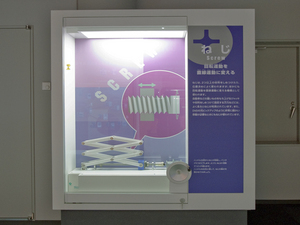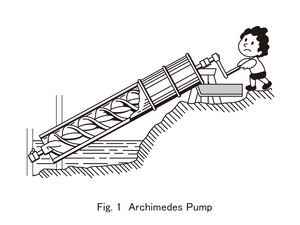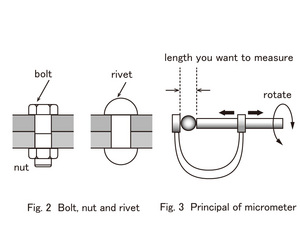Nagoya City Science Museum
TOP > Exhibition Guide > Floor Map> Screw
Screw



Purpose of Exhibition
When machines are being disassembled, you can see various components. It cannot be broken down much further. The screw is one of those components, and is certainly one of the most important ones.
The main role of a screw is "tightening up". However, it not only does that, but also performs the important function of transferring rotary motion into linear motion. We aim to deepen your understanding about the functions of screws through this exhibition.
Additional Knowledge
[What is a Screw?]
A screw is a thing which has a spiral ditch along the surface of a cylindrical or circular cone. When drawing only one line diagonally on a rectangle, then winding this rectangle and making it into a cylinder, the diagonal makes a skew curve that is called a pitch helix. The screw is what makes the ditch along this pitch helix. It's good to remember that the "external thread" has a ditch on the outside of the cylinder or circular cone, and the "internal thread" has a ditch on the inside.
[History of the Screw]
It's unknown when the screw was invented. There is the Archimedes screw pump (Figure 1). Archimedes was the first engineer who brought the helix into a machine. Many screws can also be found in DaVinci's sketches around the year 1500.
The harquebus was introduced to Tanegashima in 1543. At this time, the screw was also introduced with the harquebus. Because evidence that the screw was used before this time has not been found yet, it is believed that the screw was introduced for the first time to our country at the same time as the gun. A legend remains about a sword smith who tried to imitate the gun according to a Feudal lord's order, but couldn't figure out how to make it. Therefore, he let his daughter marry a Portuguese man to find out how to make the gun. An external and internal thread was used in the tail valve that covers the backside of the harquebus barrel.
British man Henry Maudslay invented the screw-cutting lathe in 1800. Because the lathe is also covered in the exhibit "Cutting Works", we won't go into detail here. The screw is made by rotating a cylindrical material and letting it shift parallel against the axis of rotation while laying a blade at a right angle. Proper screws were produced in large numbers and screw production became a part of the Industrial Revolution.
[Bolts and Nuts]
Now, we would like to introduce bolts and nuts that are similar to the screw. Though it is different according to the definition decided officially and in the field, according to Japanese Industrial Standards (JIS), "The bolt is the generic name of the external thread used with the nut, and the nut is the generic name of the internal thread part".
Though we already demonstrated that the role of the screw and bolt is to tighten up, in fields such as engineering, construction, and large machinery, the rivet instead was mainly used to tighten up and join metals until the 1950s. The rivet looks like a short nail; it passes through the hole made for metal boards and the part that comes out on the other side is crushed and helps to bind them (Figure 2). At first, the rivet is heated and driven into the metal. The rivet shrinks when it gets cold, and it becomes tightened strongly. Rivets are used for a part of the lower leg of the television tower in Sakae, Nagoya, and Tokyo Tower. Bolts are used for part of the upper truss. The truss is a structural form based on the triangle seen in bridges.
After tightening up, if a strong force acts upon the bolt, pulling it in opposite directions, the bolt may be torn apart rather easily. When power to pull to the bolt right and left with at right angle, that is, sharing force acts it, the bolt was tore apart easily at that time. Therefore, it was believed that it was safer to fix many rivets in place where heavy loads and particularly strong power would be applied. After the bolt started to be used more often as a high-strength steel material that could withstand large accumulated force, rivet usage gradually decreased.
[From the Rotary Motion to the Linear Motion]
The role of the screw is not only for tightening up. Transferring rotary motion into linear motion is also an important role. There is a device called a micrometer which can measure one-hundredth of a millimeter. As shown in Figure 3, slip in something you want to measure and rotate the screw part, and the length will be measured by reading the scale at the stopped position.
The interval between the pitches of the screw is assumed to be 3.6 millimeters, so when the screw rotates one degree of revolution, it moves 3.6 millimeters. In other words, when the screw rotates one degree, 3.6 millimeters of 360, it moves by 0.01 millimeters. This is the principle of the micrometer. Using this, the screw is used to make very little linear motion. For the laser beam that hits a surface such as on CDs and DVDs and reads asperity (the roughness of the surface) from them, it is necessary to move it from inside to outside very slightly with time passage. The structure of screw that transfers rotary motion into linear motion also uses such a mechanism.
Article and illustration by Koichi Mabuchi
